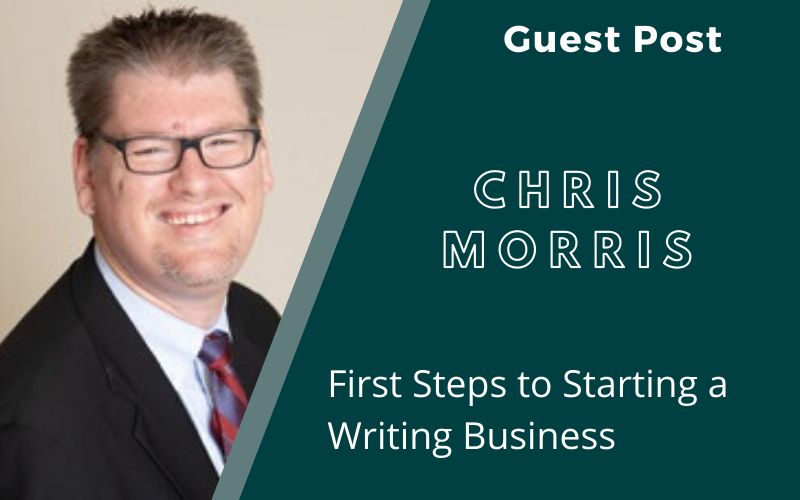First Steps to Starting a Writing Business
Chris Morris, CPA / Guest Post
CCWF Webinar Speaker: Writing Can Be So TAXING, 5/20/2020
It can be overwhelming to think about starting a writing business. So much information is available on the internet but validating which parts of that information is good and which is terrible is equally overwhelming.
Let me help. I have been working with creative entrepreneurs for almost a decade now, helping them figure out how, when, and if to start a business. I have an easy seven step process for you to think through and assess when you’re thinking about opening that writing business.
1. Build a business plan.
I’m not talking about a 94-page business plan that goes into every detail of what the business will look like – no writing business has time for or need of such a thing. Instead, your business plan should answer five key questions:
- Why do you want to have a business? You need to have an answer to this question, because at some point things will get tough. You need to have in writing why you going through all the effort to build this business in the first place.
- What are your values? I’m a bigger fan of values than I am of a mission or vision statement. Your values can and should guide your decision-making process. Let me give you an example: One of my values of my CPA firm is that I built my own firm so I can spend time with my family; this means I have a cap on how much time I spend working, and how many clients I have.
- What products or services will you offer? You have to know what you plan to offer to clients or customers before you can put out your digital shingle. Whether it’s novels, copywriting, or social media posts, you have to know what you will and won’t be doing in your business.
- What are you ninety-day and one-year goals? This is part dream and part goal, because these goals could change at any moment, but establishing goals is a key component of any business. Having goals on the front end helps you measure your progress effectively.
- What is the 5,000-foot view of how you intend to accomplish these goals? Again, you could end up going into far too much detail if you’re not careful here, so stay at the high-level view of how you will accomplish your tasks. Look to answer questions like “How will I find clients?” or “What steps will I take to find an agent?”, rather than jumping too much into the nitty-gritty details.
2. What is your ideal business structure?
There are three basic options for you at the outset of starting your business – an LLC, an S-Corp, or a sole proprietorship. There are benefits for using each of these. With both an LLC and an S-Corp, you have a layer of protection against financial loss or litigation, whereas a sole proprietorship offers no such protections. Depending upon the services you are offering, it might make sense to have this type of protection. However, if you are, for example, writing young adult fantasy novels, then you probably don’t need to worry about protection against litigation or financial losses.
Another benefit of having an LLC or an S-Corp is that is demonstrates to the IRS that you are taking your business seriously. Particularly if you anticipate recording losses instead of profits for a few years while you get up and running, this could be a valuable reason to form an LLC or an S-Corp.
An S-Corp is a slightly more complex business structure than either an LLC or a sole proprietorship. There are certain regulations around payroll and distributions that are required to be followed with an S-Corp. If you don’t want to worry about these regulations, then I would not suggest using an S-Corp.
One last clarification and thought on business structures. If you don’t create an LLC or an S-Corp, then you are by default a sole proprietorship. You don’t need to do anything to be a sole proprietorship – it’s the default type of business structure. Many writing businesses or sole proprietorships and do very well in this structure. I’m a big fan of keeping things simple, so if you don’t have a great reason to form an LLC or an S-Corp, don’t do it.
3. Open a business bank account.
As soon as you decide to open a writing business, you should open a business bank account. Let’s switch gears for just a moment for me to explain this. If the owner of your local Dairy Queen didn’t have a business account and you found out about that, how would you feel about that? It would be weird. They should have a business account for their business, because it’s a business.
The same is true of your writing business. You should open a business account and run all your revenues and expenses through that account. Not only because it’s weird for a business to not have a business account, end of year reporting will be far easier if you have a business account, and you will be able to use bookkeeping software far more easily if you have a business account. Many regional and national banks offer free starter business accounts, so you should be able to avoid paying for a minimally-used account in the beginning months.
4. Develop a vendor onboarding plan.
You should determine and outline a process for working with other vendors, which will inevitably happen. That process should include the following at a minimum:
- Always check references, and never work with someone who won’t provide you with references.
- Have every vendor complete a W-9, because you will need this information from some of them as part of your year-end reporting. Everyone who is not an S-Corp or a C-Corp that you pay at least $600 to will need a 1099-MISC from you, and the W-9 gathers the information necessary to complete that form later.
- Ensure you have accurate contact information—email, telephone, etc.
- Consider if contracts are necessary. I always default to contracts for everyone I work with, because it’s better to have a contract to specify expectations than have an ugly surprise halfway through the business relationship.
5. Figure out how you are funding the business.
This might seem like an obvious step, but I’ve seen too many people start a business without any plan for covering expenses other than assuming the revenues from the business will cover everything. That’s rarely the case in the beginning, so it’s important to consider where the money will come from when the expenses exceed the revenues.
There are four primary ways to fund a business in the beginning stages – cash, credit cards, long term debt, and crowdfunding. The ideal methods are either cash or crowdfunding, because these don’t require you to pay back the funds at any point. If you must use credit cards, then by all means do so, but this should be an exception never a rule. In my opinion, most writing businesses should not enter into a long-term loan of any sort to function. There are exceptions, but these are few and far between.
The key is that you identify how you plan to fund your writing enterprise before you open your business, so you aren’t surprised when you have to invest some money into the business. It is a near inevitability.
6. Establish a tax plan.
If your writing business is successful – as you certainly hope it will be – then you will have a tax bill to prepare for. Depending upon the level of success, there are three primary ways to approach managing your tax liability.
Particularly in the beginning stages of your business and if you or your spouse have a day job, then the easiest way to manage your increased tax liability is to increase the payroll tax deductions being pulled from your day job. This will cover the increased tax liability without having to take additional steps.
Once you have gained some momentum with your writing business, this will not be sufficient. In this scenario, you have two options. You can either sock away a portion of your profits – I suggest 20-25% – for the end of the year, or you can file estimated tax payments. There is not a big difference between the two, and the IRS is not very concerned with when they receive their money, so long as they receive it.
I cannot overstate the importance of this step in starting a new writing business. I have seen far too many creative entrepreneurs gasp at the sticker shock of their tax bill after a successful year. You want to avoid that gasp.
7. Have a back-office suite of tools set up.
There are four back-office questions you need to be able to answer as soon as you start your writing business:
- Who are your customers?
- How much do your customers owe you?
- How much do you owe your vendors?
- How much money have you made or lost so far in the year?
You need to have a suite of tools in place to answer these questions. As I mentioned above, I am a fan of keeping things simple, so there’s no reason that you couldn’t use an Excel spreadsheet to give you answers for all of these questions in the beginning. At some point, you will find the time suck to maintain an Excel spreadsheet for all of this to be too great, and you will want to explore other options.
I can give you my current recommendations for when Excel becomes more trouble than it’s worth. For maintaining your customers and your outstanding invoices, I am a huge fan of Dubsado. Dubsado is beautiful, it’s intuitive, and it’s inexpensive compared to other options that provide similar services. Here’s an affiliate link that will get you 20% off your first billing cycle.
For the other two questions, you will need a bookkeeping software. I recommend wavaeapps.com, because it’s free and provides all the reporting you will need. It works best when you have a business account, because it allows you to automatically pull in your bank transactions and will allow you to create rules based on transactions.
I hope these seven steps will help you feel comfortable with the process of starting your own writing business. If you have questions along the way, I am always giving 25-minute consultations at no cost to creative entrepreneurs to answer any questions.
You can reach out to Chris Morris here.
Sign up for his webinar on May 20, 2020: Writing Can Be So TAXING




